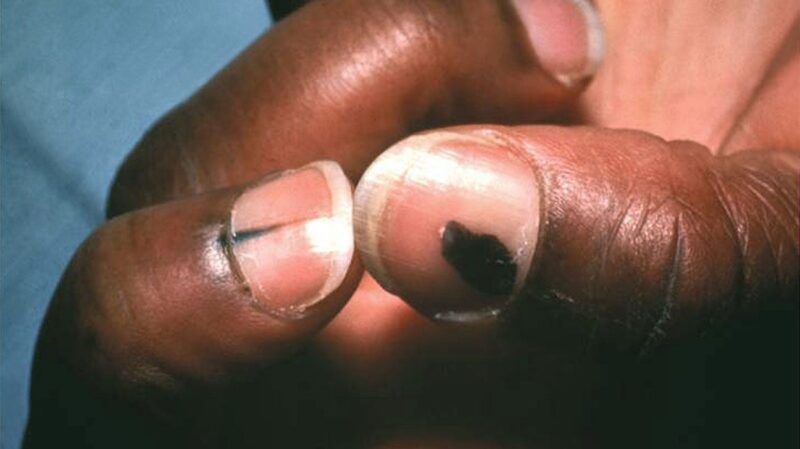Skin cancer is a common condition that occurs when abnormal cells grow and spread to the outer layer of your skin. In this article, we will be looking at 9 symptoms of skin cancer that shouldn’t be ignored.
1. Changes in a mole’s appearance
Melanoma is the rarest type of skin cancer, but it is also the fastest-growing and most lethal. Melanoma can resemble a regular mole with a few key differences. The ‘ABCDE’ guidelines are the best way to remember these differences:
Asymmetry: One side of the mole appears to be different from the other
Border: The mole’s border is irregular, uneven, or blurry.
Color: The mole has an unusual color or a combination of colors.
Diameter: The mole has a diameter of 6mm or greater (roughly the size of a pencil).
Evolving: The size, shape, color, or other characteristics of the mole have changed.
2. Skin changes following the removal of a mole
It’s natural to believe that if you’ve had a mole removed, you’re no longer at risk for skin cancer in that area. However, cancer cells can spread much deeper into the skin, far below the surface of the mole. If you’ve had a mole removed, any unusual spot or pigmentation that appears on or around the scar should be examined.

Photo Credit: Mole Map
3. Itchiness and oozing
Itching that does not go away can be caused by skin cancer. These areas are frequently misidentified as insect bites, which can delay proper treatment. Do not ignore a mole or lesion that begins to itch or itch intensely, especially if it has changed in appearance or has begun to ooze. Check it as soon as possible.
4. A spot that’s changed in looks or you see for the first time
If you see a spot that looks different or changes in appearance, it’s important to get it checked out right away. This can mean anything from a mole changing color to a birthmark growing larger.
5. A spot or sore that doesn’t heal within a few weeks
If you have a spot or sore that doesn’t heal within a few weeks, it’s important to see your doctor. The sooner you are seen and diagnosed, the better chance you have at healing it on your own.
Many skin cancers spread quickly and can spread to other parts of the body if not treated in time. In fact, it only takes about two weeks for cancerous cells to travel through blood vessels into another part of your body (like bone marrow). Doctors will be able to tell if this has happened by looking at cells under a microscope after examining them surgically removed from their original location on your body
6. A spot that’s red, tender and swollen
You may think that a spot on your skin is just an old pimple or other blemish. But if it’s red, tender, and swollen, you should see a doctor right away.
7. Scaly patches
Some skin cancers cause patches of skin to feel dry, rough, or scaly when touched. These patches are sometimes discolored, but not always. If an area of skin remains rough and scaly despite the application of moisturizing products, it could be skin cancer.
It could also be an actinic keratosis (AK), which is a precursor to squamous cell carcinoma. AKs tend to appear in sun-exposed areas of the body, including the scalp, and they become more common with age.
In any case, if you have a dry, rough, or scaly patch on your skin that does not go away with time, you should have it checked out by a professional.
8. Vision issues
While the majority of melanoma occurs on the skin, it can also appear in unexpected places such as your eyes. Melanoma in your eye, also known as ocular melanoma, or OM, frequently causes no symptoms until it is advanced. Routine eye exams are the best way to detect OM as early as possible.
Ocular melanoma is the most common primary eye cancer in adults. It can cause symptoms such as blurry vision, an increase in the number of floaters (tiny, squiggly lines that move across your field of vision), or an unusual dark or discolored spot near the iris as it progresses. OM becomes more prevalent with age.
9. Changes to your fingernails or toenails
Skin cancer can develop anywhere on the body, including under the nails of your fingers and toes. Though this can also be a symptom of a fungus infection, have it checked if you’re unsure. Melanoma typically manifests as a dark spot or streak below the nail.
Take Away!
- Check your skin regularly for changes. If you notice a change, see a doctor.
- A mole or spot on your skin is not cancer if it doesn’t grow or spread, but if it has changed from how it was before and there are other signs of melanoma (a worse form of skin cancer), see a doctor immediately. Melanoma is curable if caught early enough; however, there’s no way to prevent getting this disease altogether—just make sure that you check regularly for any changes in your body’s appearance!
Conclusion
Skin cancer is a serious condition that can cause disfigurement and even death. But if you notice that any of these signs, or symptoms of skin cancer are present, you should see your doctor immediately. Early detection is the best way to prevent the spread of this disease, so it’s vital that people take heed when they see something suspicious on their skin!
Credit: Mole Map






